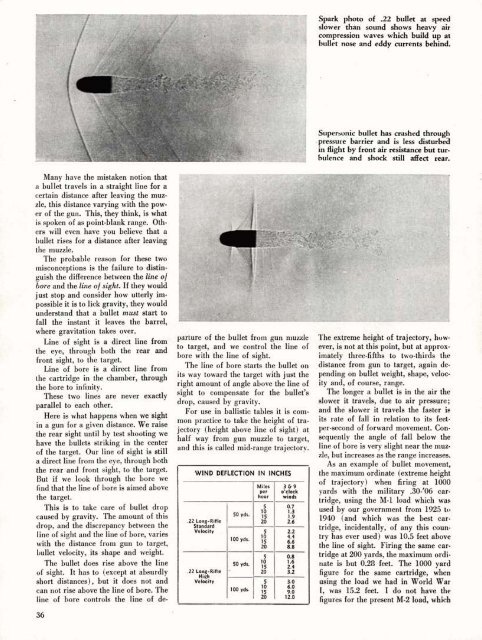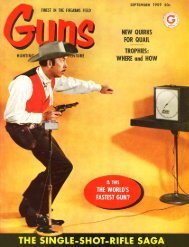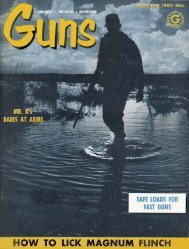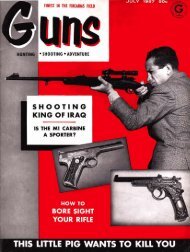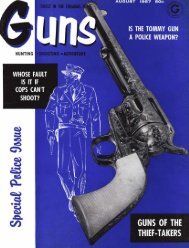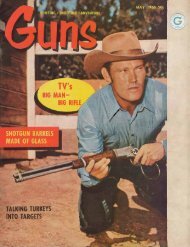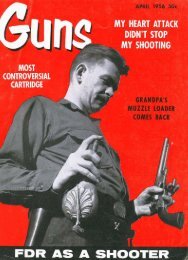Create successful ePaper yourself
Turn your PDF publications into a flip-book with our unique Google optimized e-Paper software.
Many have the mistaken notion that<br />
a bullet travels in a straight line for a<br />
certain distance after leaving the muzzle,<br />
this distance varying with the power<br />
of the gun. This, they think, is what<br />
is spoken of as point-blank range. Others<br />
will even have you believe that a<br />
bullet rises for a distance after leaving<br />
the muzzle.<br />
The probable reason for these two<br />
misconceptions is the failure to distinguish<br />
the difference between the line of<br />
bore and the line of sight. If they would<br />
just stop and consider how utterly impossible<br />
it is to lick gravity, they would<br />
understand that a bullet must start to<br />
fall the instant it leaves the barrel,<br />
where gravitation takes over.<br />
Line of sight is a direct line from<br />
the eye, through both the rear and<br />
front sight, to the target.<br />
Line of bore is a direct line from<br />
the cartridge in the, chamber, through<br />
- the bore to infinity.<br />
These two lines are never exactly<br />
2<br />
~arallel to each other.<br />
Here is what happens when we sight<br />
in a gun for a given distance. We raise<br />
the rear sight until by test shooting we<br />
have the bullets striking in the center<br />
of the target. Our line of sight is still<br />
a direct line from the eye, through both<br />
the rear and front sight, to the target.<br />
But if we look through the bore we<br />
find that the line of bore is aimed above<br />
the target.<br />
This is to take care of bullet drop<br />
caused by gravity. The amount of this<br />
drop, and the discrepancy between the<br />
line of sight and the line of bore, varies<br />
with the distance from gun to target,<br />
bullet velocity, its shape and weight.<br />
The bullet does rise above the line<br />
of sight. It has to (except at absurdly<br />
short distances), but it does not and<br />
can not rise above the line of bore. The<br />
line of bore controls the line of de-<br />
parture of the bullet from gun muzzle<br />
to target, and we control the line of<br />
bore with the line of sight.<br />
The line of bore starts the bullet on<br />
its way toward the target with just the<br />
right amount of angle above the line of<br />
sight to compensate for the bullet's<br />
drop, caused by gravity.<br />
For use in ballistic tables it is com-<br />
mon practice to take the height of tra-<br />
jectory (height above line of sight) at<br />
half way from gun muzzle to target,<br />
and this is called mid-range trajectory.<br />
WIND DEFLECTION IN INCHES<br />
50 yds.<br />
.22 Long-Rifle<br />
Standard -<br />
Velocity<br />
100 yds.<br />
.22 Long-Rifle<br />
50 yds.<br />
Miles<br />
per<br />
hour<br />
369<br />
o'clock<br />
winds<br />
Spark photo of .22 bullet at speed<br />
slower than sound shows heavy air<br />
compression waves which build up at<br />
bullet nose and eddy currents behind.<br />
- -<br />
Supersonic bullet has crashed through<br />
-pressure barrier and is less disturbed<br />
in flight by front air resistance but tur-<br />
bulence and shock still affect rear.<br />
The extreme height of trajectory, how-<br />
ever, is not at this point, but at approx-<br />
imately three-fifths to two-thirds the<br />
distance from gun to target, again de-<br />
pending on bullet weight, shape, veloc-<br />
ity and, of course, range.<br />
The longer a bullet is in the air the<br />
slower it travels, due to air pressure;<br />
and the slower it travels the faster is<br />
its rate of fall in relation to its feet-<br />
per-second of forward movement. Con-<br />
sequently the angle of fall below the<br />
line of bore is very slight near the muz-<br />
zle, but increases as the range increases.<br />
As an example of bullet movement,<br />
the maximum ordinate (extreme height<br />
of trajectory) when firing at 1000<br />
yards with the military .30-'06 car-<br />
tridge, using the M-1 load which was<br />
used by our government from 1925 to<br />
1940 (and which was the best car-<br />
tridge, incidentally, of any this coun-<br />
try has ever used) was 10.5 feet above<br />
the line of sight. Firing the same car-<br />
tridge at 200 yards, the maximum ordi-<br />
nate is but 0.28 feet. The 1000 yard<br />
figure for the same cartridge, when<br />
using the load we had in World War<br />
I, was 15.2 feet. I do not have the<br />
figures for the present M-2 load, which<br />
. .


